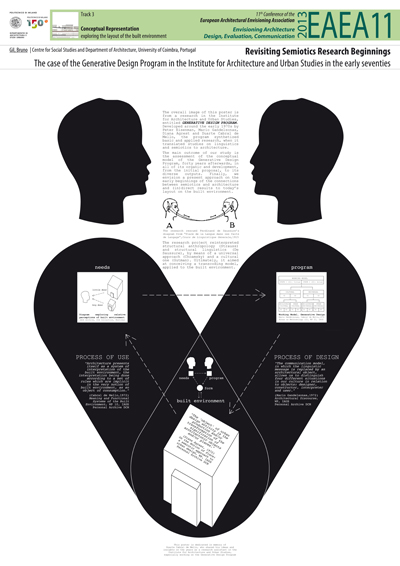11th EAEA Envisioning Architecture: Design, Evaluation, Communication Conference in 2013
Track 3 | Conceptual Representation | Exploring the layout of the built environment
Revisiting semiotics research beginnings: the case of the generative design program in the institute for architecture and urban studies in the early seventies
Keywords: built environment; architectural research; semiotics; postmodernity
ABSTRACT
Yet conquering autonomy from the realm of architecture, research has its conscious beginnings in a post-war period, in the 1950s, through the generation of several study centres, after some embryonic experiences in Bauhaus and mainly in Vkhutemas, in the 1920s.
If the integration of architecture schools into Universities brought some undesired disciplining, it also brought a more conscientious adoption of research, as foreseen by Leslie Martin in Cambridge, UK, after the Oxford Conference (1958). There, the implementation of architectural research had its more striking experience in the Centre for Land Use and Built Form Studies (1967). Curiously, it dates from the same year as the creation of the Institute for Architecture and Urban Studies (IAUS), in the other side of the Atlantic, by Peter Eisenman, a few years following his education precisely in Cambridge, which culminated in his PhD The Formal Basis of Modern Architecture (1963).
In this period of an interdisciplinary understanding of architecture, supported by the conviction of a social engaged architecture with its milieu, the IAUS developed several studies, publications and exhibitions.
The present study envisions a deeper comprehension of a single research around the early seventies – the Generative Design Program, by Peter Eisenman, Mario Gandelsonas, Diana Agrest and Duarte Cabral de Mello. Even if this research had its validation in that very specific context, it synthetized basic and applied research, when it introduced the translation of linguistics and semiotics to architecture.
The language of architecture was central to the postmodernity beginnings, focusing on signs as elementary entities of a visual grammar. Denise Scott Brown and Robert Venturi in Las Vegas (1972) advanced an investigation mixed between the analytical and the pop, making use of semiotics as a tool.
In a different way, the IAUS’s semiotic studies were detailed through a grounded approach on theoretical principles. The Generative Design Program proposed the interpretation of structural anthropology (Strauss) and structural linguistics (De Saussure, Choamsky), through a universal approach (represented by Choamsky) and a cultural one (exemplified by Gutman). Ultimately, it aimed at being applied to the built environment.
The main outcome of this paper is the assessment of the conceptual representation model of the Generative Design Program, forty years afterwards, in all of its organic and development, from the initial proposal, to its diverse outputs (background, goals, feasibility, hypotheses, contributions and working papers), by means of interviews with the original research team and the contents of the IAUS’s archive in the Canadian Centre for Architecture.
Finally, it envisions a current approach on the early beginnings of the interconnections between semiotics and architecture and (in)direct results to today’s layout on the built environment.
AUTHOR
Bruno Gil
Centre for Social Studies and Department of Architecture, University of Coimbra, Portugal
